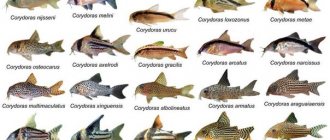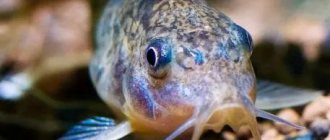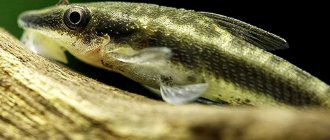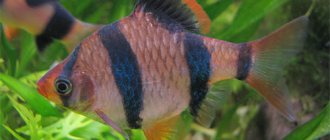Corydoras panda is a South American species of catfish, which got its name due to its similar coloration to the giant panda. Corydoras panda is an ideal fish for beginners, it does not require special conditions, is very hardy and calm. Basic information about the features of keeping a panda:
| Brief information | |
| Scientific name: | Corydoras panda |
| Used names: | Corydoras Panda, Panda Cory, Panda Catfish, Panda Catfish, Panda Cory, Panda Corydoras. |
| Family | Armored catfish (Callichthyidae) |
| Origin: | Peru; river basin Ucayali |
| Adult size: | 5 cm |
| Character: | peaceful, friendly fish |
| Lifespan: | 10+ years |
| Occupied levels in the aquarium: | lower |
| Minimum aquarium volume: | 39 liters for 4-5 individuals, 45cm x 30cm x 30cm. |
| Nutrition Features: | omnivores, specially designed tablets for catfish, live food, brine shrimp, bloodworms, daphnia. |
| Reproduction: | spawning fish |
| Difficulty of care: | average |
| Water acidity: | pH: 6.0-7.0. |
| Hardness of water: | 2-12 dGH |
| Temperature: | 20-25 °C |
Origin and distribution
The popular species Corydoras comes from Peru, where it is found in the river basin. Ucayali - in one of the sources of the Amazon. It was discovered by G. R. Richards in 1968, but was not named until three years later. The name was given in honor of the Chinese giant panda. Surprisingly, the attractive catfish imitates the coloring of this animal.
The area from which Corydoras Panda originates is known for its neutral, slightly acidic water, soft due to a lack of minerals. These waters are cooler than other tropical areas.
When this fish was first discovered, it was quite expensive to purchase.
Captive breeding programs for the Panda Corydoras have yielded results and significantly reduced the price. As a result, it has become not only quite inexpensive, but also extremely popular.
Reproduction
Breeding the Panda Corydoras is easy. Fish reach sexual maturity at 8-10 months.
You will need to prepare a separate spawning tank with a volume of at least 30 liters, with a filter and a small amount of shelter. Water is needed with an acidity of 6.5 pH and a temperature of 23°C.
It is recommended to take care of the correct lighting : slightly darken the entire aquarium, and, on the contrary, illuminate one place in it. The female will lay eggs there.
Plants with small leaves or moss should be placed in the aquarium. It is optimal to use Javanese.
The selected group is placed in the spawning tank . One female needs at least two males . The fish are fed generously with live food.
After the female’s belly has noticeably rounded, it is necessary to change the water to colder (a couple of degrees) in a volume of up to 70%, which simulates the rainy season. For this purpose, filtration is increased. Cool water is added every day until the eggs appear.
During spawning, the female lays up to 100 eggs . Most often on plant leaves or directly on glass.
When the spawning is over , the parents are moved to a common aquarium.
To prevent fungus from appearing on the eggs, add a few drops of methylene blue to the water. If the fungus still appears , you need to remove the affected eggs.
The fry hatch from the eggs in 3-6 days. It is important that there are no temperature changes during this time.
The emerging fry are given special food or ciliates.
Description
Panda Cory's body is not completely white, but is a faint pinkish tint with three noticeable dark markings. One on the head, at the top, covers the eyes like a black mask. The next black spot is located on the dorsal fin, and another one is at the base of the caudal fin. The size of the spot at the base of the tail varies.
This fish owes its name to its unusual color, reminiscent of a bamboo bear.
The fish has bony plates on its sides, and the rest of the body is covered with horny scales. Corydoras has three pairs of antennae, as well as several sharp scutes for protection. There is one shield under the eyes, in front of the dorsal fin, and another on the adipose fin. Adults can grow up to 5.5 cm in length, but often remain smaller.
Description of the species
Corydoras panda are peaceful, bottom-dwelling catfish. Peru and Ecuador are considered their homeland. They live in neutral, acidic and clear waters. The body of the fish has a high back, it is dense and slightly compressed from the sides.
This species is light in color with a slight pink tint. On the sides of catfish there are three black spots, and they are located strictly in certain places, namely:
- around eyes;
- on the dorsal fin;
- near the caudal fin.
Corydoras has large eyes on his head, and a little lower is his mouth. Its body is covered with small scales, and there are bone plates on the sides. There are three pairs of whiskers around the mouth of this aquatic inhabitant. With their help they navigate in the water and get food. And for protection in front of the eyes and next to the dorsal fin there are special sharp shields.
The average size of an adult fish is 5.5 cm, and in an aquarium, under favorable conditions and proper care, it can live up to 15 years.
The panda catfish received its name due to its similarity in color to the panda.
Relationships with other fish
Corydoras pandas are extremely friendly fish that love company.
They should always be kept in groups, preferably half a dozen or more, but at least three or four if space is limited. Corydoras pandas are very social and get along well with other bottom dwellers, for example, Botsia Macracanta.
Compatibility table of panda corydoras with other inhabitants of the aquarium.
Catfish get along well with almost all fish, but you should not keep them with large, noisy, aggressive species. For example, tiger barbs are not the best companions due to their tendency to bully others. Small and medium-sized Tetras, Danios and Rasboras are good neighbors for Panda Cory. Other small catfish such as Aspidoras are also suitable.
Maintenance and care
Catfish require high-quality water. It is important to replace it regularly. Filtration and aeration systems are required. The water you need is soft and slightly acidic-neutral. Recommended temperature 22 °C. This species comes from a region with water temperatures lower than other tropical fish species. Almost all captive-bred panda corydoras can tolerate warmer temperatures.
The soil you need is soft, fine-grained or sandy. Live vegetation is ideal, but not required. The aquarium should contain decorations that provide shade and shelter. Caves, rocks and snags are excellent means for catfish to feel comfortable. Floating plants, real or artificial, are needed to provide shade.
Feeding
Tetra Cory ShrimpWafers food is a special food for Corydoras catfish.
Corydoras are excellent “scavengers”; they grab any food that falls to the bottom. However, if they are adjacent to other fish, care should be taken to ensure that enough food reaches the bottom. Melting tablets or granules are a great option.
A varied diet is important for good health. Include live or frozen food in your menu. Shrimp, worms, insects and any crustaceans are welcome. They are especially fond of bloodworms, shrimp and daphnia. Specially formulated food tablets for catfish are an excellent choice. Keep in mind that this species is active at night. Before turning off the light in the aquarium, throw in a few of these pellets.
Diseases
The panda catfish rarely gets sick, but it is worth monitoring the manifestation of the first symptoms and taking timely measures.
The onset of the disease may be indicated by the appearance of spots or growths on the scales. Typically, this is a sign of parasites or fungi.
If the fish is breathing heavily and constantly rising closer to the surface of the water , it is most likely suffering from nitrogen poisoning .
Bacterial infection is especially dangerous. With it, reddish spots appear on the abdomen. Sick fish must be removed urgently, as the disease is very dangerous.
When buying a new fish, you need to take preventative measures, as it could have gotten sick in the pet store. The new catfish is housed separately for two weeks , and a few drops of Antipara .
If an illness occurs, you should not give medications with a high copper content and use salt baths. The correct treatment will be prescribed by a veterinarian, whom you should contact if you have any doubts about the health of the fish.
Breeding
Initially, the breeding of this fish was considered quite difficult, but time has proven that spawning of Corydoras panda is possible in a home aquarium.
How to distinguish a male from a female
Sexual dimorphism in corydoras pandas.
The female corydoras panda is larger and wider than the male when viewed from above, and has a more rounded underbelly. Males are smaller and shorter in length than females.
When breeding measles, 2 males per female are recommended. The bottom of the breeding tank should be covered with Java moss or other similar plants for the eggs to be laid. The aquarium must have good aeration. Future parents need to be well fed with bloodworms, shrimp or daphnia. Spawning can be caused by a partial (50-70%) change of water to colder water in order to imitate the breeding conditions in nature that occur during the rainy season - the winter season in our latitudes.
When the female is ready to spawn, she will agree to be courted by the male. As a result, they form a classic T-position with their bodies, which can be observed in many Corydoras species. The female lays one or two eggs, which are subsequently fertilized. She then looks for a place to hide the sticky eggs in the vegetation. This process will continue until about a hundred eggs have been laid and fertilized within a few hours. These eggs have a sticky layer and are light yellow in color.
Video: Corydoras panda spawning
Adults can eat the eggs, so it is better to hatch them after spawning. Add a few drops of methylene blue to water to prevent mildew . Some hobbyists even use certain types of freshwater shrimp to collect fungal spores. Cherry shrimp, Neocardina heteropoda work well. They will eat diseased eggs and leave healthy ones unharmed.
After about 4 days, the eggs will begin to hatch. They are quite sensitive to water temperature, which should not exceed 22 °C. The fry should be fed with special ready-made food. The quality of water is extremely important; water changes should only be carried out with the same parameters. It will take about 3 months before the fry reach the adult colors.
The popularity of the corydoras panda remains unchanged, and captive breeding of this species is now widespread. Catfish Corydoras is one of the most popular and accessible species of measles among aquarists. It ranks among the top choices for beginners as a peaceful, hardy, and easy-to-grow fish.
Reproduction and breeding
Despite the ease of keeping and feeding, achieving successful spawning is not so easy. Reproduction of panda corydoras is only available to experienced aquarists.
- Before spawning, the fish begin to be fed intensively, focusing on protein and, if possible, live food. Bloodworm, daphnia, cyclops.
- Since individuals live in flocks, pairs mostly form on their own. It is easy to distinguish a male from a female - the female is larger and thicker, the male is more miniature . The selected pair is transplanted into an equipped spawning tank.
- For spawning, a 40-liter aquarium is sufficient, with a water temperature of 23 -25 ° C, ph 6-8, dh 10-20. The bottom is covered with sand, and live plants must be planted. Preferably Amazon, Java moss, floating plants. For successful spawning, you need several shelters so that the fish chooses the right one.
- After transplanting a pair of pandas, the water should be replaced with clean, settled water, with a temperature 1-2 degrees higher, since in the natural environment rainstorms stimulate fish to spawn.
Spawning
During spawning, the male chases the female around the aquarium, pushing her in the stomach and pinching her tail and fins. When both partners are ready, the male lies on his side, and the female presses against him with her “jack”, lips to the anal fin, taking milk for fertilization. The female panda corydoras lays the fertilized eggs on the leaves of plants or inside shelters. The first time the fish is able to lay up to 10 eggs, during subsequent spawnings 25-30.
Fry
The fry appears on the 3-4th day, depending on the temperature, with a size of about 4 mm. The fish grow quite quickly. With appropriate feeding, by one month the fry reach a size of 10mm. For the first two days, the fry feeds independently, using the yolk sac. As soon as the sac resolves, you need to start feeding ciliates, crushed daphnia. As they grow, they switch to food for adult catfish. These are bottom tablets or ground flakes. By the 12th week, the fry are completely colored.











